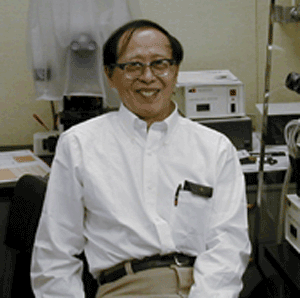 Dr. George Liang
Dr. George LiangDr. George H. Liang, educator and geneticist, retired on 31 January, 2006, from the Department of Agronomy at Kansas State University after nearly 42 years of service. He was born in China and completed his high school and college education in Taiwan. He then received his M.S. degree from the University of Wyoming, Laramie, and his Ph.D. from the University of Wisconsin, Madison. He joined Kansas State University as an assistant professor on 1 October, 1964. He was promoted to associate professor in 1969 and to full professor in 1977.
George served as Chairperson of the Interdepartmental Program of Genetics from 1982 until 2004. His specialties are plant genetics, including cytogenetics, quantitative genetics, and molecular genetics. He and his colleagues were among the first to transform grain sorghum plants carrying genes from wheat and rice. His work on genetic modification to incorporate a chitenase gene in wheat and sorghum for insect resistance is pioneering. His papers have appeared in the major journals of the world, including Journal of Heredity, Botanical Gazette, Crop Science, Canadian Journal of Genetics and Cytology, Euphytica, Plant Breeding, and Theoretical and Applied Genetics.
Internationally known, George was a consultant for the World Bank and the United Nations Development Program in China. He started his trips to China in 1979 soon after President Nixon opened up China in 1972. Between 1991 and 1996, he was the lead consultant for the United Nations Development Program in China and advised on the five major crops of the country, wheat, corn, foxtail millet, sorghum, and potato. The problem at the time was seed waste by the farmers. They over-planted, because they were not sure of percent germination. Dr. Liang helped to develop a seed certification system, so a farmer could be sure, when he got seed, that he could get 80 % germination, for example, if the seed was certified for that number. This saved a large amount of acreage from over-planting that could otherwise be used for food production, and, at the same time, saved the farmer much time bending on his knees to thin his crops. A Chinese farmer now can plant less and save money, because he needs to buy fewer seed. In July 1999, Dr. Liang was invited by the Chinese Ministry of Science and Technology to advise the Ministry on privatization of its biotechnology program. The Ministry wanted to model itself after Monsanto, where the research would be self supporting by the patented material produced. Dr. Liang suggested that four biotechnology institutes be set up, instead of one in Beijing, to ensure that all parts of China be represented. Dr. Liang's consultations have helped change China from a food-importing country in 1979 to one of self sufficiency. His achievements are remarkable and a great service to mankind.
Dr. Liang instructed students world-wide, including those from China, Thailand, South Korea, Egypt, Tunisia, and India. Until his retirement, he taught graduate level Plant Genetics (since 1968) and Quantitative Genetics (since 1975) courses. One hundred and thirty graduate students, post-doctoral fellows, and visiting scientists worked in his laboratory. The students took the information that they learned from him back to their home countries, where they, in turn, can help produce more food for the growing millions.
Together with his colleagues, he has published 12 book chapters, 120 refereed journal articles, and three books: Plant Genetics (Second Edition); Experimental Principles and Methods; and Genetically Modified Crops (with D.Z. Skinner).
Dr. Liang is Fellow of the American Society of Agronomy and the Crop Science Society of America. He received the Distinguished Faculty Award of Gamma Sigma Delta in 2002. He was elected honorary professor by China Agricultural University, the Chinese Academy of Agricultural Sciences, Henan Agricultural University, and Shandong Academy of Agricultural Sciences.
He is married to Dr. Doreen S. Liang, a graduate of the University of Wisconsin, Madison, who specialized in Pharmaceutical Chemistry. They have a daughter, May, and a son, Roy. He and his wife have retired to La Jolla, California.